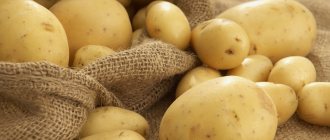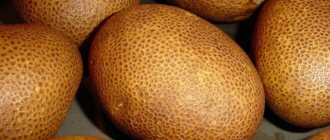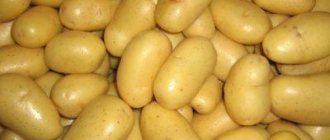Description of the potato variety Gulliver
Gulliver potato variety belongs to the mid-early category. For full ripening it takes 60-70 days. Bred in Russia at the Institute of Household Economy. Recommended for growing in central regions where it is not cold. The bushes grow tall, stand straight, and do not fall. They are an intermediate type with matte, dark green foliage. The corolla is small and purple. The buds fall off quite quickly. One bush can ripen 5-11 potatoes at the same time. The root system is always well developed.
Interesting!
The Gulliver variety is most often grown specifically to produce young potatoes.
Potato yield Gulliver 350-450 c/ha
The tubers are elongated oval in shape. The weight of commercial root crops is 130-150 g. Sometimes you come across very large or small potatoes, but this happens rarely. The peel is white. The eyes are small and superficial. The flesh is dense and creamy. Starch content 11-14%. The pulp does not darken when cut and practically does not soften during cooking.
Characteristics of the Guliver variety
Potatoes "Gulliver" are a table variety of early ripeness. The ripening period for new tubers is 60-70 days from the moment of planting. Potato shoots are long-growing. Young tubers reach a weight of 130-150 grams. The shape of the tubers is an elongated oval. The flesh is cream-colored. The skin is thin, smooth and shiny. The color of the tubers is yellow.
On average, 5-11 tubers are formed under one bush. Harvest from one bush up to 2 kg. Farmers collect 600-700 quintals from one hectare. Starch content 11-14%. The keeping quality of tubers in winter is estimated at 94%. Potatoes do not darken during heat treatment and slicing. The main use is consumption in the form of new potatoes. Suitable for preparing any dishes.
The plant is drought-resistant. Variety resistance to diseases:
- moderately resistant to: Alternaria;
- weakly resistant to rhizoctonia, scab;
- resistant to: cancer, nematode, late blight.
It is recommended to grow in the Central and Central Black Earth regions of Russia. Has high marketability.
Characteristics of Gulliver potatoes
Also check out these articles
- Early plum varieties
- What is the best way to treat potatoes before planting?
- New Zealand white rabbit
- Breed of chickens Hisex Brown
In addition to describing the plant, it is also useful for gardeners to become familiar with the general characteristics of the Gulliver variety.
- The variety is drought-resistant.
- Gulliver does not grow well at low temperatures, and even short-term cold spells can delay the development of the bush.
- Root crops of commercial quality. Bad ones, unsuitable for transportation or sale, make up about 2% of the total harvest volume.
- Transportability is high.
- The immunity is strong, resistant to most potato diseases: late blight, potato cancer, nematode, alternaria.
- Keeping quality of tubers is 94%.
- Productivity 350-450 c/ha.
- Table type of potato, very tasty, universal type.
Choose a sunny, flat place with mineral-rich soil for planting.
Advantages and disadvantages of Lina root vegetable
Potatoes "Lana" are a medium early variety characterized by high yield. The main advantages of this type of root crop are the following:
- Suitable for both cooking and production of chips. Due to its marketable appearance, this plant variety is very popular in the market;
- The variety is not susceptible to potato canker and the action of microorganisms that contribute to the development of late blight. However, the golden nematode poses a danger to the plant;
- Differs from many other varieties in good taste;
- Has an excellent presentation;
- Frost resistance, drought resistance;
- In addition, this variety does not require special care.
Disadvantages of the variety:
- High starch content – up to 18%;
- The umbilical part is strongly pressed into the tuber.
One of the highest-yielding types of root crops is “Lina” potatoes. The positive characteristics of this variety were compiled by the best specialists in the field of plant growing; the root crop is resistant to droughts and heavy rains. The peculiarity of the root vegetable is that the plant does not require special care, but has an attractive presentation: a smooth surface with small eyes, an oval shape. All fruits are practically the same size.
How to grow potatoes
It is necessary to plant Gulliver potatoes when the weather is warm outside, without severe frosts. Choose a sunny, flat place with mineral-rich soil. The land for planting is fertilized in the fall. For the winter, humus or fresh manure is added to it (if the soil has high microbial activity). If it was not possible to fertilize the soil in the fall, then during planting the fertilizer is applied directly into the holes. You can add a shovelful of loose humus, a pinch of superphosphate and a small amount of wood ash.
Important!
If fertilizers are applied during planting, directly into the holes, it is necessary to mix them with the ground to reduce the concentration.
To obtain a quick, rich harvest, it is recommended to germinate the tubers in advance. A month before planting, they are laid out in shallow boxes in 1-2 layers and placed in a bright room at a temperature of +15...+17 degrees Celsius. Sprouts should appear on the tubers, and the peel itself, as a rule, will partially or completely turn green during this time. The tubers are planted in holes at a distance of 35-40 cm, not thicker, otherwise the bushes will interfere with each other’s development.
Landing
Gulliver potatoes are planted in the same way as any other variety of these root crops. Many gardeners who have been growing potatoes for many years know how to do this correctly, but for novice potato growers this process becomes a big problem. Having no experience in planting and growing potatoes, they make many mistakes that can be avoided if they approach the matter correctly. In the table, we noted quite common mistakes made by beginning gardeners, indicated their undesirable consequences, and answered the question: how to do it right?
| You can't do that | Why | How to do it right |
| On a plot with a slope, rows of potatoes are planted along the slope | Natural moisture quickly flows down, plantings do not receive enough water | Potato rows are always planted across the slope |
| Tubers are planted too deep or not deep enough | New root crops are poorly formed, will be small, and when planted superficially, the tops will grow rapidly | The optimal depth for planting potatoes is no more and no less than 15-20 cm |
| There is too little or too much space between rows and plants | Dense plantings prevent the bushes from ventilating, and sparse plantings lead to rapid drying out of the soil | The distance between rows should be 50-60 cm, between bushes 35-50 cm |
| Fresh manure was applied before planting | Root crops overfed with nitrogen fertilizers will actively increase green mass, but not tubers | Organic fertilizers should be applied in the fall or rotted manure should be used in the spring, adding 1 bucket per 2 square meters. m before landing |
| Large tubers were used for planting | Large root crops, as seed material, will produce small new tubers | It is better to plant potatoes of medium or small size; large potatoes are cut into several parts, leaving 2-3 eyes on each |
| The seed material is not germinated | The growth and formation of new tubers is delayed for 2-3 weeks | Potatoes are removed from the cellars 1-2 months before planting and placed in a warmer and brighter room |
| Potatoes were not treated with fungicides before planting | Plantings are at risk of fungal diseases | 2 hours before planting, spray the seed with solutions of copper sulfate or other special means against diseases and pests |
How to sew rompers and a baby vest for newborns: a pattern with a sewing description. Patterns of vests and blouses for little ones. || Baby vest. Patterns of vests
Care and harvesting
We recommend reading our other articles
- Indian Runner Duck
- Canned fish in an autoclave
- Perennial asters
- The best varieties of pears for the Moscow region
Gulliver potato harvest
It is necessary to begin caring for potato beds no earlier than the first shoots appear. Before this, the plantings are not touched so as not to damage the sprouts hiding underground.
- Watering begins 1.5-2 weeks after planting. Average water consumption is 15-20 l/m. sq. However, this indicator may vary depending on climate and soil type. Potatoes of this variety especially need a lot of moisture during the period of tuber formation.
- The earth is loosened regularly. You should not forget about this rule. It is necessary to constantly maintain the row spacing in a well-groomed condition, remove weeds, weed the area between the bushes so that the potatoes have enough oxygen.
- Fertilizers guarantee rapid growth and excellent taste of the crop. Most of the nutrients are added when digging the site for the winter or during planting. And during the growing season, it is recommended to feed the crop only in certain cases, for example, if the plant grows slowly or the weather deteriorates. Thanks to the introduction of nutrients, the plant's resistance increases and it begins to develop normally again. Wood ash or minerals (phosphorus, potassium, nitrogen) can be recommended as a top dressing.
- Hilling is carried out 2 times per season. The first time – when the sprouts become 20 cm long on average, and the second – 2-3 weeks after the first procedure.
Features of agricultural technology of the variety
The first step in the growing process is preparing the soil. Fertilize it with fertilizer enriched with minerals and nutrients. It is better to do this in the fall before the onset of frost by adding lime to the soil. 20-30 days before going deep into the ground, shake off the soil from the planting material and transfer it to a well-ventilated place. Treat each tuber with a weak solution of potassium permanganate.
Choose the most suitable place on the site for growing tubers; it should be well lit. Wait until the soil temperature warms up to 10-12 degrees and the night frosts disappear. Proceed with planting Gulliver potatoes as follows:
- Build a ridge up to 15 to 20 cm high if the groundwater in the area is located near the surface of the earth. This will save the root system from rotting.
- Dig holes or furrows so that the distance between them is at least 35-40 cm.
- Deepen the sprouted tuber into each hole so that it is located no lower than 8 cm from the soil level.
- Fill the hole or furrow with soil. Level the top surface of the ridge.
You can first cut the root vegetables into several parts, but each of them must have a vegetative shoot, which is responsible for the process of germination and reproduction.
The good yield of the Gulliver variety depends not only on proper planting, but also on the competent care that this varietal crop requires. If the summer is dry, then water the plant 3-4 times per season - before the appearance and during the ripening of buds, before and after flowering. Periodically loosen the soil after planting the seed, this is necessary to improve oxygen saturation in it.
The Gulliver variety is distinguished by tall bushes, so carry out the hilling procedure 2-3 times a season, this is necessary to support and ensure good fixation of the plant crop. Throw soil onto the bush for the first time after it sprouts, then when it reaches a height of 15-20 cm, the last time after flowering.
Diseases and pests
Diseases and pests of potatoes Gulliver
The good immune system of the Gulliver potato variety allows gardeners to encounter diseases and pests only in rare cases. This greatly simplifies the care of the crop. The Gulliver variety is not affected by potato canker, Alternaria blight, late blight, and potato nematode. But with improper care, some fungal diseases can occur.
Important!
Experts recommend treating young bushes to prevent rhizoctonia and scab. The variety has only average resistance to these diseases.
If serious problems arise, you must immediately treat the bushes with fungicides or insecticides and, if necessary, repeat the procedure after a while. As for the Colorado potato beetle, they fight it with manual assembly, traps, and bait.
Reviews of the Gulliver potato variety
Only in rare cases can you hear a bad review about Gulliver potatoes. This is the elite among all kinds of varieties - productive, easy to grow and tasty.
- Nina Zuiko : “For beginning gardeners, which is what I consider myself to be, the Gulliver potato variety is the best! It grows quickly, care is simple, and the yields are large. I tried to grow other species, but they either get sick often or don’t give birth at all. So for me, Gulliver is the optimal one. Of course, the harvest is not enough for a long time, because we are starting to eat young potatoes, but this is for the best, since we do not have a large cellar for storage.”
- Nikolai Petrenko : “I never thought that Gulliver was suitable for long-term storage, but last year there was a very large harvest. I had to put some of it in the basement for storage. It lay without problems, the potatoes did not spoil at all. I don’t know exactly how long it can last, but in our case, the last one was eaten in February. The taste and quality were no worse than in the summer. So now we are planting larger quantities so that it lasts longer.”
- Pavel Shumeiko : “I grow the Gulliver variety to produce young potatoes. He has no equal in this category. Root vegetables are tasty, do not get overcooked, are suitable for frying and do not darken during cutting. As for growing, there are practically no problems. The main thing is that there are no strong cold spells after planting. And due to the early ripening period, it is rarely affected by diseases and pests.”
Reviews from gardeners
A friend of mine advised me to plant the Gulliver variety. I took several fruits for testing, and 2 months after planting I decided to dig them up. The tubers are even, but there are not many of them, about 6-8 pieces on each bush. The taste is excellent, the fruits boiled quickly. During the entire growing period, I only treated the plants against the Colorado potato beetle twice, but the potatoes did not suffer from anything.
We plant Gulliver every year; it is the most successful early variety. There are still old potatoes from last year stored in the cellar and they taste normal, there is no sweetness. Before planting, I add a little ash to the ground, about a glass per square meter, and sprinkle onion peels into the prepared holes so that insects do not eat the potatoes, this helps in the future.










